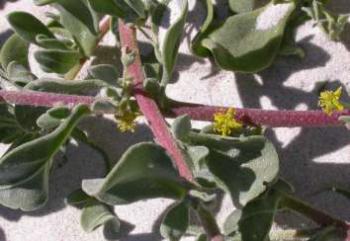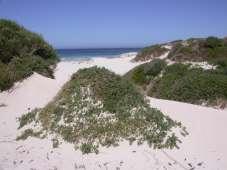Tetragonia decumbens
Tetragonia decumbens Mill.
Family: Aizoaceae
Common names: dune spinach (Eng.); duinespinasie (Afr.)
Introduction
This widespread dune plant is edible and also performs an important role in stabilizing the sand, enabling the dune to develop into a friendly environment for other plants.

Description
Description
This is a spreading shrub with dark green, sessile, glistening leaves.The sheen is caused by small, shiny, water-storage cells that cover the surface of the leaf. The small, 4-petalled, yellow flowers are situated in groups of 3-5 in the upper leaf axils. They flower from August to November. The fruits are thickly 4-winged.

Distribution and habitat
Distribution description
Found on coastal sand dunes from southern Namibia to the Eastern Cape.
Derivation of name and historical aspects
History
The genus name is derived from the Latin word, tetragonus which means 4-angled, relating to the fruit, and decumbens means prostrate with tip rising upwards.

Ecology
Ecology
An early colonizer of moist sand dunes, it is an extremely valuable plant for stabilizing moving sand. It acts as a seed-trap and also provides organic matter that enables other species to grow on the dunes. The accumulation of plants matter such as that of Tetragonia decumbens, and the subsequent establishment of other plants, enable dunes to develop from fore dunes to rear dunes that are stabilized by increasing plant growth. The four-angled fruits are easily blown about by the wind, aiding their dispersal.
Uses
Use
Apart from their very important use to stabilize moving sand, the plants are also edible. The new growth, which occurs during the rainy season, is the best to use. The tops and leafy stems are harvested and must be thoroughly washed to remove the clinging sea sand. They are then boiled and because the flavour is rather bland, one of the traditional Cape seasonings, in the form of Oxalis pes-caprae, and a blob of butter added to the dish make it more palatable. The texture of the resulting spinach is somewhat grainy, but not unpleasant. Raw leaves have a somewhat salty taste. It is thought that with appropriate selection, the plant could be domesticated, yielding a crop similar to its close relative, New Zealand spinach, Tetragonia tetragonioides.
Growing Tetragonia decumbens
Grow
The easiest method of growing this plant is to pull up branches from the sand and separate pieces with roots attached as cuttings. These can be planted directly in situ into well-drained, sandy soil, which must be kept slightly moist until the plants have established themselves.
Pests and diseases: The leaves are occasionally chewed by insects, but are more likely to be damaged to a very small extent by strong winds and sandblasting. Trampling also causes damage.
References
- Adamson, R.S. & Salter, T.A. (eds). 1950. Flora of the Cape Peninsula. Juta, Cape Town & Johannesburg.
- Manning, J.P. & Goldblatt, P. 2000. Wild flowers of the fairest Cape. Red Roof Design & the National Botanical Institute, Cape Town.
- Smith, C.A. 1966. Common names of South African plants. Memoirs of the Botanical Survey of South Africa No. 35.
- Van Wyk, B-E. & Gericke, N. 2000. People's plants. A guide to useful plants of southern Africa. Briza Publications, Pretoria.
Credits
Jane Forrester
Harold Porter National Botanical Garden
April 2004
Plant Attributes:
Plant Type: Ground Cover, Perennial
SA Distribution: Eastern Cape, Northern Cape, Western Cape
Soil type: Sandy
Flowering season: Spring, Early Summer
PH: Alkaline, Neutral
Flower colour: Yellow
Aspect: Full Sun
Gardening skill: Average
Special Features:
Horticultural zones








Rate this article
Article well written and informative
Rate this plant
Is this an interesting plant?
Login to add your Comment
Back to topNot registered yet? Click here to register.